Apple MacBook Pro 13: Can a Mac Be a Decent Windows Laptop?
by Vivek Gowri on October 14, 2010 9:00 PM ESTApple MacBook Pro 13—Surprisingly Powerful 320M
Ah yes, the NVIDIA GeForce 320M, a.k.a. the excuse given for why the MBP13 is still running Core 2. It’s an integrated chip, with 256MB of system memory allocated to the IGP. As I said before, it’s got 48 CUDA cores clocked at 450 MHz, compared to the G 310M (in most of ASUS’ ultraportables) which has 16 CUDA cores at 625 MHz. It’s based on NVIDIA’s GT216 core and is basically an integrated version of the GeForce GT 325M. Interestingly, NVIDIA also has a similarly (and rather confusingly) named GT 320M (found in the HP dv6/7t) but that is a dedicated card with a stripped version of the GT216 core and has 24 pixel pipelines clocked at 500 MHz.
So, there’s your NVIDIA mobile GPU lesson for the day. But here’s the basics—the 320M is the replacement for the old 9400M and is basically a GT 325M integrated into the chipset. We expect it to run squarely in between the ASUS ultraportables and the N83Jv/Alienware M11x (GT 335M), slightly slower than the GT 325M, and somewhere around the ATI HD 5470. Here's how gaming performance stacks up.
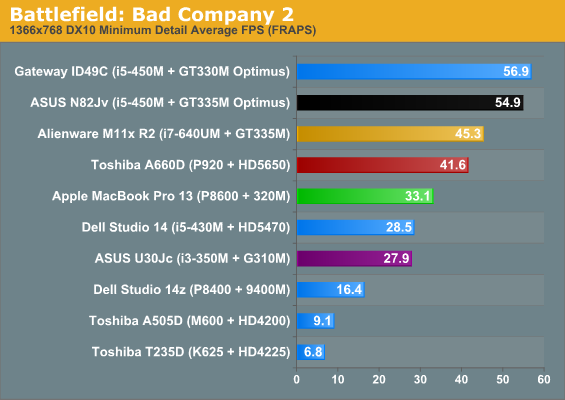
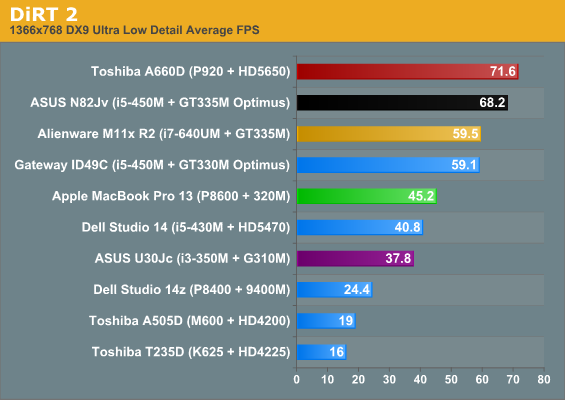
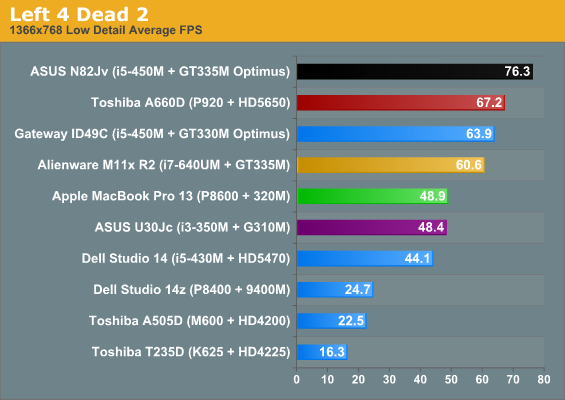
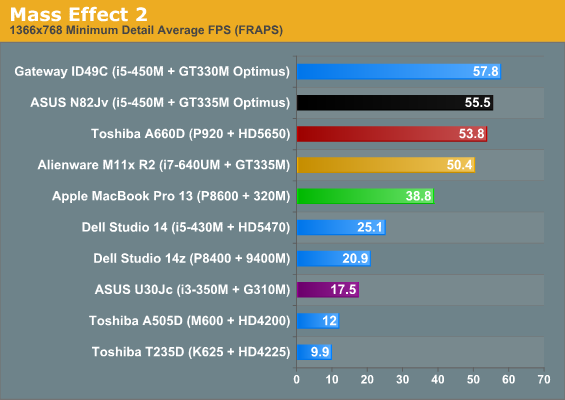
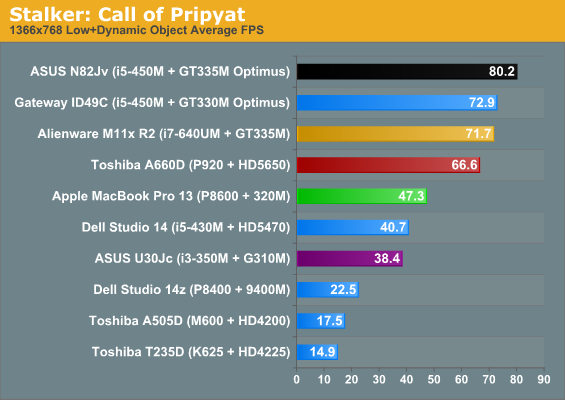
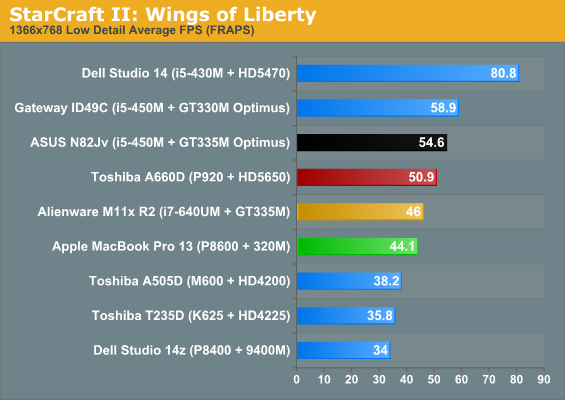
Under low settings, the MBP ended up around 10% faster overall than the Dell Studio 14, which has the HD 5470 (excluding the StarCraft II number). The Alienware M11x, ASUS N82Jv, and Gateway ID49C remain quite a bit faster, as expected, while the ASUS U-series end up significantly slower. The other integrated solutions (9400M, HD 4200/4225) are comparatively woeful. With the G 310M, you can play basically everything in our benchmark suite (except Mass Effect 2) at native res, lowest detail settings. With the other integrated graphics solutions, you need to take the resolution down a few notches to get anything even resembling a playable frame rate.
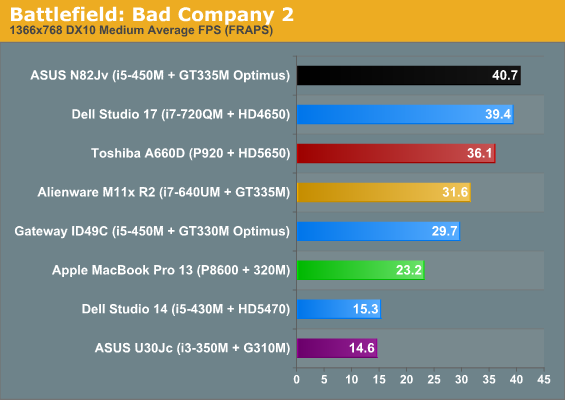

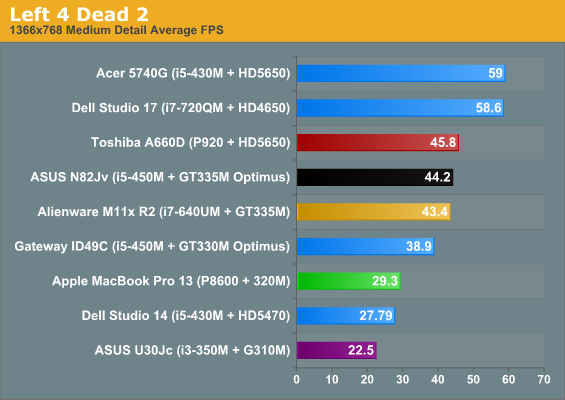
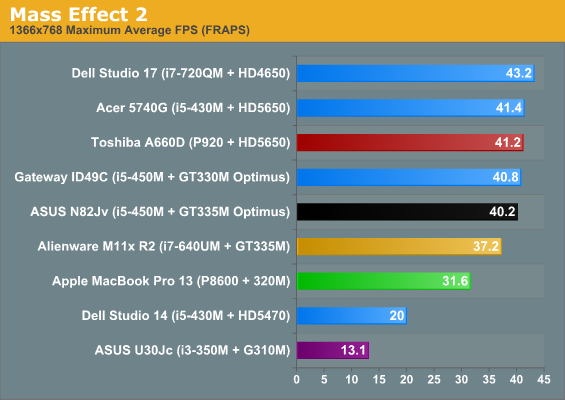
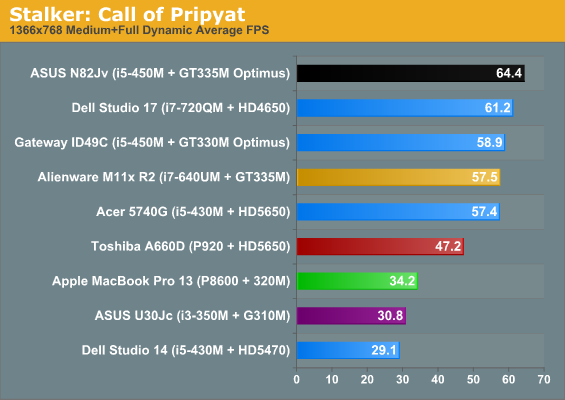
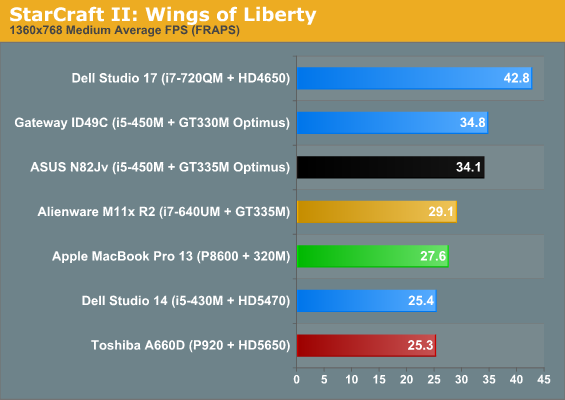
At medium detail settings, I expected the 320M to falter, but it surprised me by staying playable in all of our benchmarks. Bad Company 2 is a bit low, but if you really want to play it at Medium it’s possible, unlike with the G 310M and other low end dedicated graphics units. Frame rates in the mid-20 to low-30 range are awesome by mobile IGP standards. Things that aren’t playable on the G 310M, like Mass Effect 2 and Left 4 Dead 2, hit the magical 30 fps mark with the 320M. The 320M performs more like a midrange mobile GPU than any shape or form of integrated graphics; this is understandable given it’s roots as an integrated GT 325M, but it's still pretty awesome.










117 Comments
View All Comments
seapeople - Wednesday, October 20, 2010 - link
The entire argument that "Macs have to be more expensive because Apple has to pay for..." is a moot point, because Apple makes GOBS of money off EVERYTHING they sell, especially including Macbook Pros. Macs are more expensive than PC's marginally because they cost more to make, but substantially because Apple simply has a product/brand name combination so desirable by people that they can sell it at huge price markups.To summarize: yes, there is a good reason that Macs are more expensive than PC's... it's because Apple likes to make money, and who can blame them? If you buy a $1500 laptop from Dell, you get ~$1400 of premium hardware crammed into a cheap plastic case with barely adequate build quality that trades quality for cheapness in every place you can see just so Dell can squeeze a $50 margin out of the machine and stay afloat through their mass marketing ability, whereas if you buy a $1500 laptop from Apple you get ~$700 of hardware fitted with top of the line externals including a unique and beautiful aluminum-alloy chassis, premium screen, and best-in-class touchpad that allows Apple to pull down a $500 margin and remain as the only company in the world with no debt. The Dell machine appeals to value-hungry tecno-inspired nerds who can give you the exact model number of the processor in their cheap plastic-looking machine, while the Apple machine appeals to normal people who don't necessarily know why their new shiny computer doesn't have a right click option but they're too embarrassed to ask and so just ignore it.
zefyr - Thursday, October 14, 2010 - link
I would really like to see you include the HP envy 14 in your comparison. Of all the pc laptops i think its the most comparable.VivekGowri - Thursday, October 14, 2010 - link
If you can get HP to send us one, we'd certainly include it. We've to date been unable to get HP to respond to our request for a review unit, so that ball is squarely in their court, not ours.Friendly0Fire - Sunday, October 17, 2010 - link
I'm pretty sure this might have to do with their supply issues with the Radiance screen.To be honest, I find these Mac articles a little useless and yes, biased, if you don't include the direct competition to them. I'm not buying an Asus for a stylish aluminum body or a super-high quality display, I'm buying one because it offers tremendous bang for your buck, great performance and acceptable quality. If I wanted a Mac and looked at options similar to it, I'd bring up a Vaio Z and an Envy 14 and then I'd make a strict comparison between the three. Both of those laptops would most likely utterly trash the Macbook Pro 13 and even then 15.
It's obvious that comparing a BMW to a Hyundai, the BMW will win (well, as long as price isn't a factor, which it of course isn't here). It isn't as obvious if you also get the Mercedes and the Lexus in the mix.
I understand that you don't have the bazillions that'd be required to buy out and test every laptop around, yet I can't shake the feeling that you're putting out a grossly wrong picture that only casts Apple in a near-godly figure, which annoys the hell out of me. If other, comparable choices are available for less money, it's just doing the consumer a disservice not to clearly mention it.
Thermogenic - Thursday, October 14, 2010 - link
Why not let the Alienware use it's 335M?VivekGowri - Thursday, October 14, 2010 - link
That's just a quirk in the graph's labeling, I think. I'm pretty sure Jarred didn't artificially limit the Alienware's performance when he tested it.JarredWalton - Friday, October 15, 2010 - link
Sorry, my mistake on a few charts. I retested the M11x R2 using the IGP at one point to show how it compared with the AMD HD 4200 IGP. Those results were put in the application charts, which changed the scores in PCMark and 3DMark (particularly in the latter). I've updated the charts with the correct 335M scores. Thanks for the catch!Focher - Thursday, October 14, 2010 - link
What I find interesting in the review - which was quite thorough and fair - is that the "value" part really came down to only the price-to-CPU comparison. In reading your section about the display, you castigate other manufacturers for cutting corners (and costs) on the display quality and compliment Apple. It seems Apple made the same call, but opted for the higher quality display and the lower quality (in terms of processing power) CPU. I only would point out that even the review mentions that the processing power of the C2D CPU is more than sufficient for typical usage patterns.I will admit my bias that Apple's industrial design tends to have me at hello, and for raw processing power I would never consider a notebook anyway.
JarredWalton - Friday, October 15, 2010 - link
Here's the thing: the CPU and IGP should be going for a song these days, which means that the cost of all the hardware minus the chassis and LCD is significantly less than the competition. Take the $1000 ASUS N82Jv and put the MBP13 chassis and LCD in there, and by all means it's a $1200 laptop that we'd happily recommend. (That would be $100 extra for the LCD, and $100 extra to make the chassis better.) Unfortunately, what Apple has done is to take something more like a $600 laptop, add in a good chassis and LCD, and they're charging $1200 for it.Based on the components, design, peripherals, etc., the MBP13 should go for more like $1000, and the standard MacBook could go for as little as $750, but of course Apple has no interest in lowering prices that far as long as people are willing to pay $1000 and $1200.
solipsism - Friday, October 15, 2010 - link
You’re only looking at a few aspects of the total product. Intel’s Price List doesn’t have the C2Ds being that much cheaper than the newer chips. Again, it seems like the lesser of two evils over using Core-i + IntelHD or sticking with C2D for a generation and having a better dGPU.I think too many companies focus only what can be marketed on a spec sheet and not what is useful for the average user. Anand readers are not the average user. This means compromises, just like a notebook-grade components cost more and are slower than desktop-greade components.
But the worst conclusion is determining what a product *should* go for by simply looking at a component or a few components of another product. Did you consider the cost of milling the aluminium chassis. Did you consider the cost of using green, recyclable materials and manufacturing methods (I don’t care about this but it does affect the cost)?
But most importantly, it doesn’t sound like you considered supply and demand? I know this a tech-based site but in business you sell a product at what the market can bare in order to maximize your profits. You don’t look at the same of a few parts of a competitor and then match their price regardless of profit. That’s asinine!
Let’s not forget that Apple has a “boutique”-like product line while most other big vendors have excessive model numbers. They simply can’t command the price point that Apple can. That doesn’t mean they are being altruistic;, they would get more profit from customers if they could.